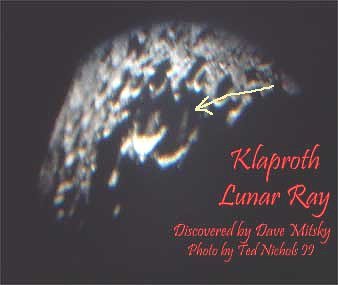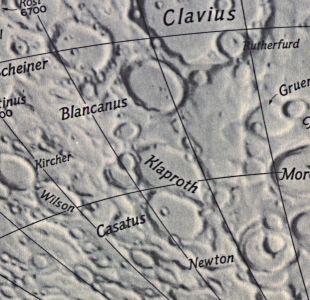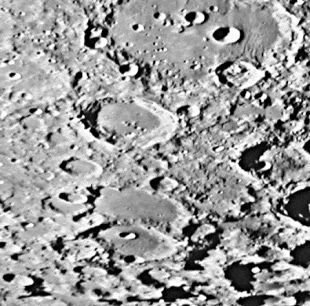
Observer: Dave Mitsky
Date: 2004/10/8
Time: 07:20 UT
Location: ASH Naylor Observatory, Lewisberry, Pennsylvania
76d53'4" west, 40d8'54" north
Elevation: 190 meters
Seeing: very good
Transparency: good
Dome Temperature: 13 degrees Celsius at the end of the session
Instrument: 17" f/15 classical Cassegrain equatorial mount
Oculars: 17mm Pro-Optic Ploessl (381x), 25mm University Optics MK-70
(259x), 32mm U.O. Koenig-II (202x), 40mm U.O. MK-70 (162x)
At approximately 7:20 UT (3:20 a.m. EDT) on Friday morning I noticed a very prominent sunset lunar light ray in the flooded wall plain Klaproth. This 119 kilometer diameter crater was named after the German chemist and mineralogist Martin Klaproth. It features high crater walls reaching to 4300 meters and a flat floor. Klaproth is located at 69.7 degrees south, 26.0 degrees west, and is south of the very large crater Clavius. Adjacent to it to the south is the crater Casatus.
The ray was easily seen while scanning the terminator at 162x. It was rather thin and extended across the crater diagonally to the northeast. When I stopped observing the ray at 08:00 UT it had not changed appreciably.
Fellow ASH member Ted Nichols II imaged the ray with his digital camera.
========== and from Tony Donnangelo ===========
Observer: Tony Donnangelo
Date/time of observation: 2004/10/08 06:33 U.T.
Site location: Tuscarora State Forest, PA, USA
Site coordinates: N. 40.51° W. 77.63°
Site elevation: 427 meters (1402 feet)
Site classification: State forest wilderness area
Instrument: 14.5 Starmaster Dob.
Magnifications: 107x, 152x, 203x
Moon's age: 23d 16:00, Illuminated: 60.1%
Librations: 7.7°, PA 162°, N/S -7.28°, E/W -2.39°
Object: Klaproth (flooded walled plain)
Crater size: 122X122Km. (72x72Mi.); Height: 4300 meters (13,000 ft.)
Height/Wide ratio: 0.0361
Lunar ray coordinates: 30.0°W, 69.0°S
Rukl chart #: 72
Description from Virtual Moon Atlas: Circular formation forming a double crater with Casatus. Few steep slopes supporting Klaproth A to the north, Casatus H to the southwest, and Klaproth G and H to the west. Very high walls. Very flat floor separated from Casatus by a line of crest. Craterlets.
I was setup before sunset. There were only a few stray clouds during the night. Heavy dew started forming at nightfall but lessened by 07:30 U.T. I began observing the moon as it rose above the tree line at 06:33 U.T. Seeing was turbulent, but transparency was very good. Seeing became much steadier as the moon rose higher.
I immediately noticed a strikingly prominent, bright, slightly cone-shaped beam of light cast on the crater floor that stretched from the western to eastern wall. It may be visible at an earlier time. Approximately two-thirds towards the eastern wall, there was a raised area, possibly the wall of a craterlet, casting a shadow perpendicular across the ray. The ray emanated from a complete break in the western wall.
The eastern half of the crater was within the terminator. The eastern crest was illuminated with some very bright peaks. The western wall was completely illuminated, and the floor was completely shadowed except for the ray.
The eastern interior wall of the crater Casatus, directly south of and creating a double crater with Klaproth, was extremely bright and wide, revealing the gradual slope of the wall. There was an interesting swath of light on its otherwise shadowed floor. It had a wide, rectangular shape that was quite long. It was caused by a wide, low section of wall on Casatus western side. It remained virtually unchanged during my observing session.
By 07:00 U.T., the ray began to thin. I decreased magnification because of the turbulence in seeing. Within 50 minutes, it was no longer cone shaped. At 08:20 U.T., the ray remained the same width but shortened slightly toward the west. My last observation was at 08:55 U.T. It appeared the same length, hair thin, and very dim.

